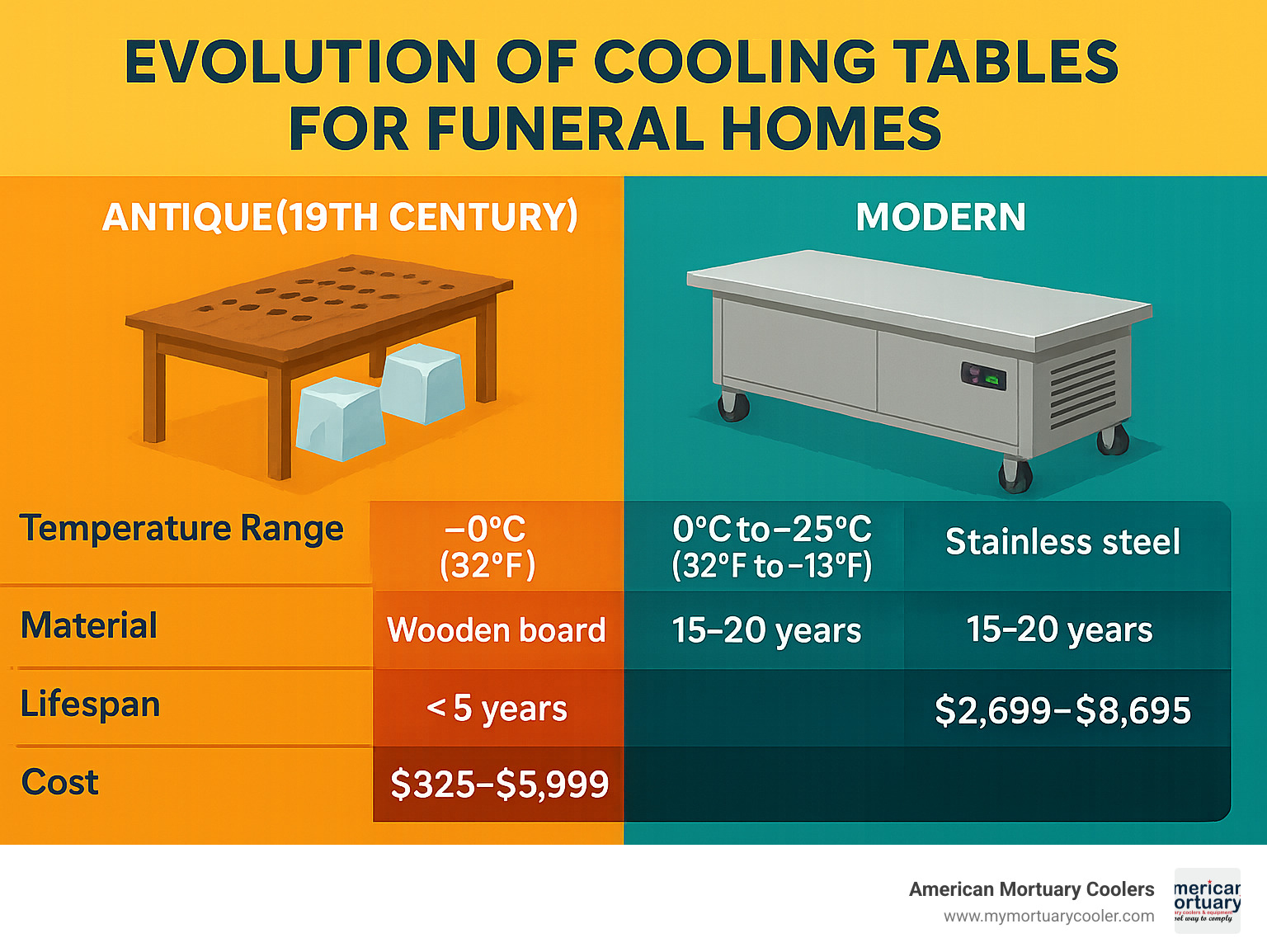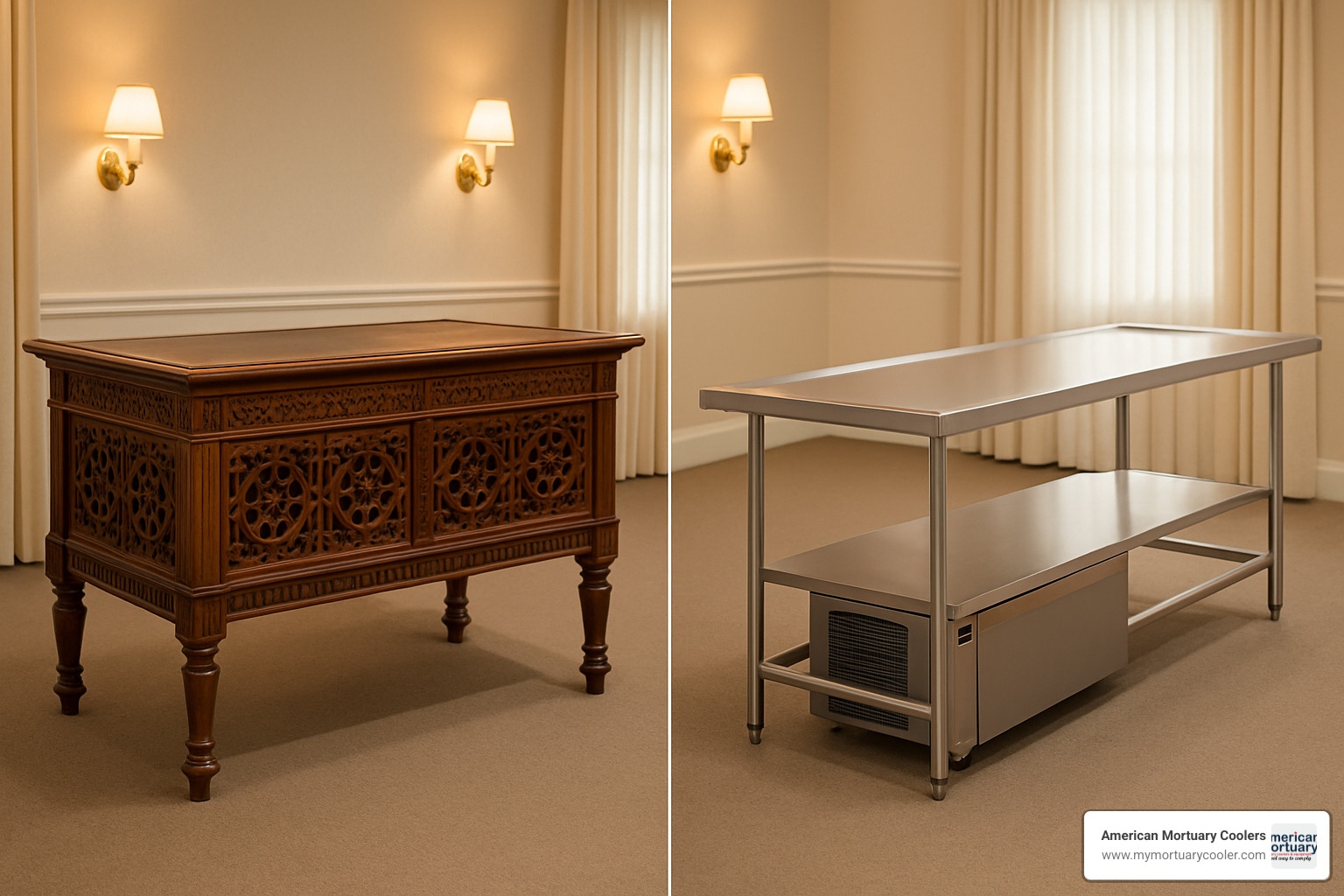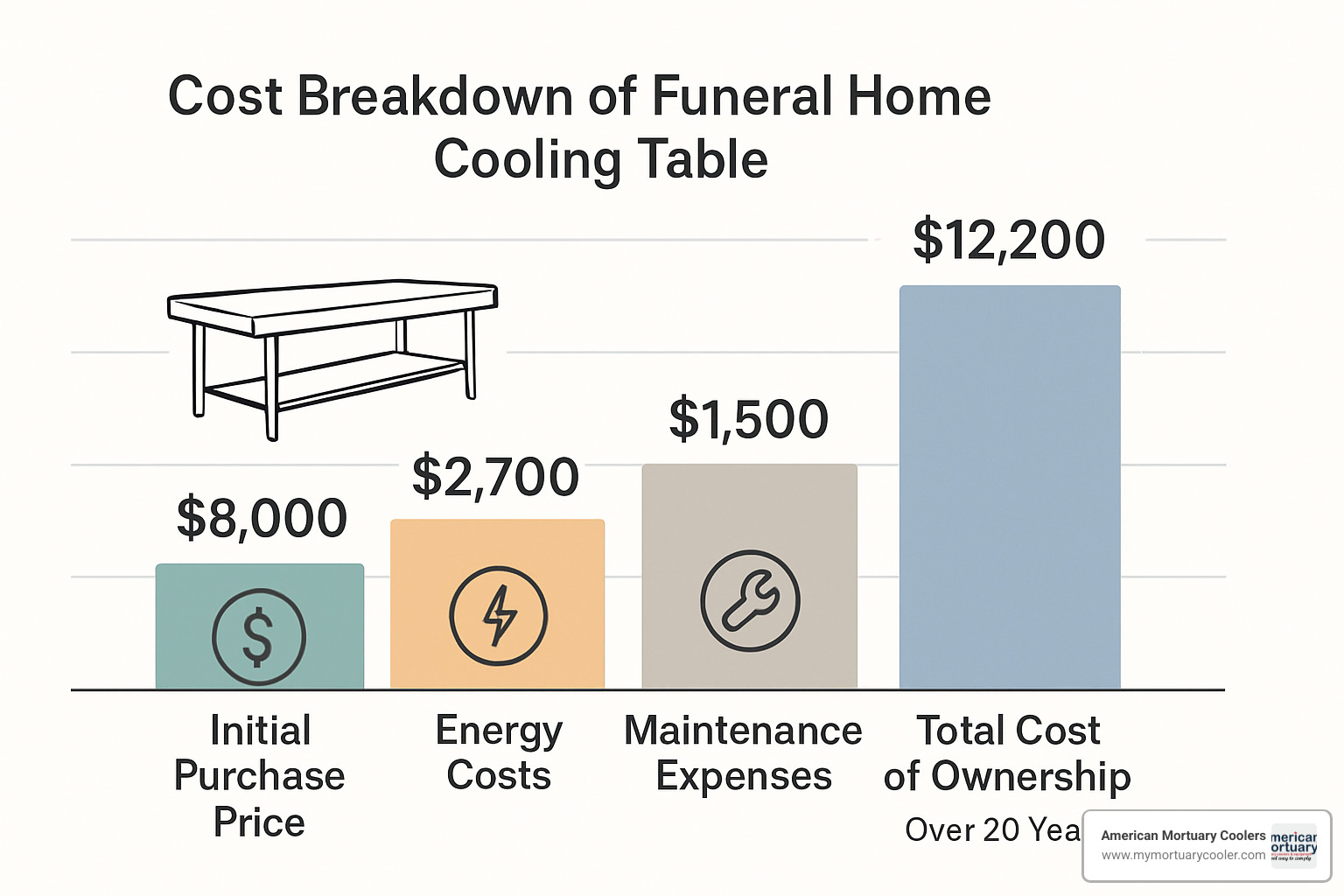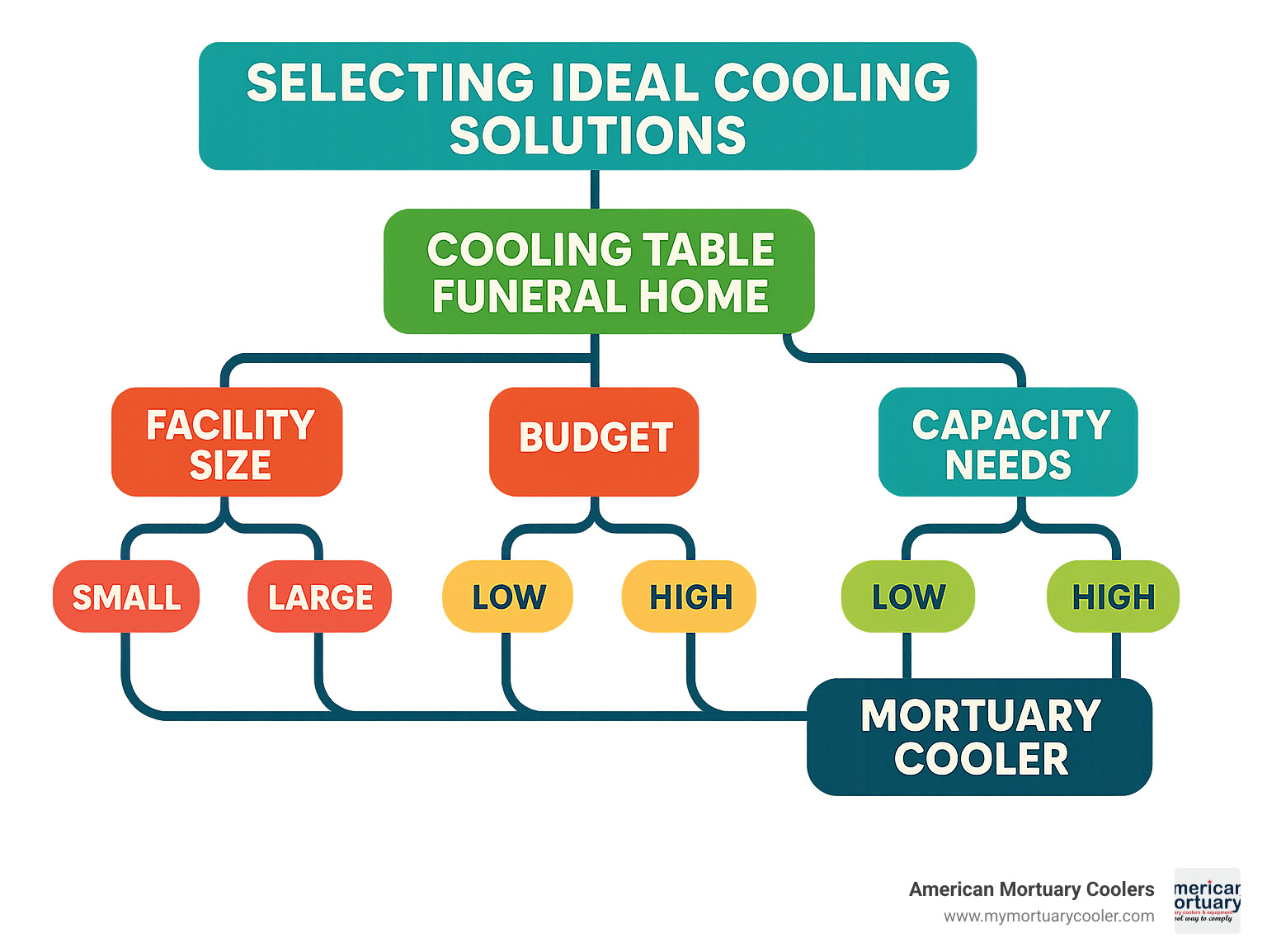Why Understanding Cooling Tables is Essential for Modern Funeral Operations
Cooling table funeral home equipment serves a critical role in preserving human remains with dignity while meeting modern health and safety standards. These specialized tables maintain proper temperatures to slow decomposition and provide a respectful environment for viewing and preparation.
Quick Answer for Funeral Directors:
- Antique cooling tables (1800s-early 1900s): Wooden platforms with ice underneath, priced $325-$5,999 for collectors
- Modern cooling tables: Stainless steel with digital temperature control (0°C to -25°C), priced $2,699-$8,695
- Key difference: Modern tables offer precise refrigeration vs. ice-dependent antique models
- Best choice: Stainless steel tables with 15-20 year lifespan and 5-year warranties
The evolution from simple wooden "cooling boards" to today's sophisticated refrigerated tables reflects both technological advancement and changing funeral customs. In the 19th century, families relied on perforated wooden platforms with ice blocks - a system requiring constant attention with limited temperature control.
Today's funeral directors need equipment that meets strict health codes, operates reliably around the clock, and fits facility space and budget constraints. Modern cooling tables deliver consistent temperatures, require minimal maintenance, and integrate seamlessly with other mortuary equipment.
As American Mortuary Coolers with extensive experience as a national mortuary cooler supplier, we've helped countless funeral homes steer the transition from outdated cooling table funeral home setups to modern, compliant systems that improve both operational efficiency and family satisfaction.

From Cooling Boards to Stainless Steel: A Brief History
In 1850 rural Tennessee, when death visited a farmhouse, families reached for wooden boards stored in barns - their cooling table funeral home solution passed down through generations. Death wasn't something that happened behind hospital walls; it was a family affair in the parlor where everyone gathered.
The original cooling boards were simple inventions born from necessity. Families needed to preserve loved ones long enough for relatives to travel from distant towns, sometimes taking days by horseback. These perforated wooden platforms, crafted by local carpenters, solved pressing problems with ingenious engineering.
Ice blocks placed underneath created natural cooling systems preserving bodies for several days. In harsh Appalachian winters, families moved these setups to barns where cold air helped maintain proper temperatures until spring thaw made burial possible. There's a fascinating article about this practice titled "Put the corpse in the barn till spring" capturing how matter-of-fact these arrangements were.
Even President Lincoln's remains were placed on a cooling board in the White House - proving that whether you lived in a log cabin or the nation's most prestigious address, everyone relied on the same basic technology.
Traveling undertakers emerged during this era, carrying folding cooling tables from farm to farm. These early funeral directors were mobile service providers, bringing expertise and equipment to families during their darkest hours. Their portable tables featured folding legs and carry handles, making them the Swiss Army knives of 19th-century funeral equipment.
Everything changed after World War I and the influenza pandemic. Death moved from homes to hospitals and dedicated funeral establishments. The simple cooling board had to evolve or become obsolete.
Antique Cooling Table Design & Features
The craftsmanship of antique cooling tables tells a story of respect and ingenuity. Most featured solid oak frames built to last generations. The perforated platforms were works of art using wicker cane latticework that allowed cold air circulation from ice below while providing drainage.
Brass hinges allowed legs to fold for storage and transport. Adjustable head rests ensured proper positioning, while leather carry handles made two-person transport possible. Every detail was thoughtfully designed, including child-sized tables reflecting higher infant mortality rates of that era.
Today, these antique pieces command serious collector interest, priced $325 to $5,999 depending on condition and provenance. The beautiful patina and intricate latticework make them fascinating artifacts blending practical engineering with respectful artistry.
Historical Significance in Funeral Customs
The cooling table was the centerpiece of 19th-century mourning rituals. Wake durations of 2-3 days were standard, giving extended family time to travel and community members opportunities to pay respects. Without these cooling systems, such lengthy viewings would have been impossible.
The mourning parlor served as the heart of these ceremonies. After the influenza epidemic, many families started calling this room the "living room" - they wanted distance from death associations. That name stuck and we still use it today.
This transition from home-based customs to modern cooling table funeral home operations represents more than technological advancement - it reflects a fundamental shift in how American families handle death and mourning.
Cooling Table Funeral Home: Antique Versus Modern Technology
The leap from antique wooden cooling boards to today's sophisticated refrigerated tables represents one of the most dramatic advances in funeral equipment. Antique cooling tables relied entirely on ice blocks for temperature control, creating constant uncertainty about preservation conditions. Modern refrigerated tables maintain precise digital control from 0°C to -25°C, eliminating the guesswork funeral directors once faced.
| Feature | Antique Cooling Tables | Modern Refrigerated Tables |
|---|---|---|
| Material | Oak wood, wicker cane | Stainless steel |
| Temperature Control | Ice blocks (variable) | Digital thermostat (0°C to -25°C) |
| Airflow | Natural convection | Forced air circulation |
| Sanitation | Manual cleaning only | Antimicrobial surfaces |
| Mobility | Folding legs, handles | Optional casters, forklift compatible |
| Lifespan | 50+ years (with care) | 15-20 years |
| Maintenance | Ice replacement, wood care | Annual service, digital monitoring |
| Cost | $325-$5,999 (antique) | $2,699-$8,695 (new) |
The materials tell their own story. Where antique tables featured oak frames and wicker cane latticework, modern units use stainless steel throughout. This isn't just about durability - stainless steel conducts cold 80 times more effectively than plastic alternatives, dramatically reducing cooling time and energy consumption.

How Modern Refrigerated Tables Work
Today's cooling table funeral home equipment operates like precision scientific instruments. The heart of each system is a digital thermostat maintaining exact temperatures without ice-based cooling guesswork. Most units offer bidirectional heating to prevent icing - a sophisticated feature that would have seemed like magic to early funeral directors.
Stainless steel construction provides the foundation for consistent performance. The material's superior thermal conductivity means bodies reach target temperatures faster, while smooth surfaces resist staining and facilitate thorough cleaning between uses.
Blower plenums capture vapors directly at the source, improving air quality in preparation rooms while protecting funeral staff from exposure. Many units include forklift compatibility for safe body transfers, reducing physical strain on staff.
Most modern tables carry 5-year warranties when properly maintained, with average service life of 15-20 years. The 340-watt energy consumption keeps operating costs manageable while delivering reliable 24/7 performance.
Benefits & Limitations of Antique Cooling Tables
Antique cooling tables possess undeniable charm that modern equipment can't match. The craftsmanship and aesthetic appeal make them fascinating historical artifacts, with solid oak construction that can outlast several generations of modern equipment when properly maintained.
Collectible pricing ranges from $325 to $5,999, making them attractive to funeral history enthusiasts. However, significant limitations restrict their practical use in today's funeral operations. Temperature control remains entirely dependent on ice availability, creating inconsistent preservation conditions requiring constant monitoring.
Modern health codes often prohibit porous materials like wood in body preparation areas due to sanitation concerns. Insurance issues present another hurdle, as many carriers refuse coverage for facilities using non-certified equipment.
At American Mortuary Coolers, we've helped funeral homes transition from various legacy systems to modern, compliant equipment. While antique tables deserve respect as historical artifacts, today's regulatory environment and family expectations require the reliability that only modern cooling table funeral home technology can provide.
How to Choose the Right Cooling Table for Funeral Homes
Choosing the right cooling table funeral home equipment becomes manageable when broken into key considerations. After helping funeral directors nationwide make these decisions, we've learned that systematic evaluation simplifies the process.
Your capacity needs come first. Consider how many bodies you typically handle simultaneously, not just average daily volume. A 2-body cooler works well for smaller operations, while high-volume facilities often need 4-body configurations or larger setups.
Viewing room size determines whether you need mobile or fixed installations. Mobile units with casters provide flexibility but need maneuvering space. Fixed installations offer stability but lock you into one layout. Budget considerations extend beyond initial $2,700 to $6,000 prices to include installation costs and ongoing energy consumption (typically 340W at 230V).
Warranty coverage varies dramatically between manufacturers. Look for comprehensive packages covering mechanical components (usually 5 years) and structural elements (often 15 years). Hygiene standards aren't negotiable - most jurisdictions require stainless steel surfaces in body preparation areas.
For budget-conscious operators, DIY options like CoolBot systems paired with standard air conditioners can create effective walk-in cooling solutions for around $5,000 - significantly less than traditional compressor systems.
Maintenance Tips for Cooling Table Funeral Home Operators
Proper maintenance prevents 2 AM emergency service calls. Daily sanitation should become second nature using appropriate disinfectants on all surfaces with quick visual checks of seals and gaskets. Stainless steel surfaces need specific cleaners to maintain antimicrobial properties.
Weekly temperature log reviews catch problems before they become emergencies. Digital thermostats should show consistent readings within target ranges. Annual professional service isn't optional for warranty coverage and reliable operation. Keep detailed maintenance logs for warranty claims and regulatory compliance.
Gasket checks deserve special attention. These rubber seals keep cold air in and warm air out. When they fail, compressors work overtime and energy bills skyrocket. A $50 gasket replacement beats a $2,000 compressor repair every time.
Cost & ROI of a Cooling Table Funeral Home Investment
Understanding real ownership costs helps justify cooling table funeral home investments. Purchase prices typically range $2,699 to $8,695 for modern refrigerated tables, depending on capacity and features needed.

Energy consumption averages 340W at 230V, translating to modest monthly operating costs. Over 20-year lifespans, energy expenses remain minor compared to initial investment. Maintenance costs average 5-10% of purchase price annually for routine service and minor repairs.
The return on investment goes beyond dollars and cents. Reliable cooling equipment prevents service disruptions that could damage reputation and lose families to competitors. Financing options make high-quality equipment accessible with 0% down payment plans and extended terms matching cash flow patterns.
Legal, Health & Ethical Considerations
Running a cooling table funeral home means navigating complex regulations protecting both staff and families you serve. OSHA compliance forms the backbone of workplace safety requirements, needing proper ventilation systems and documented safety protocols.
State health codes typically require body storage at 37°F (2-3°C) or below. Modern cooling tables with digital monitoring make compliance straightforward, automatically recording temperatures and alerting you to deviations. The old days of guessing temperatures with ice-based systems don't meet today's standards.
CO₂ ventilation becomes critical when using dry ice for supplemental cooling. Many funeral directors are switching to dry ice alternatives like polymer refrigerant sheets, offering similar cooling benefits without gas hazards.
Religious sensitivities require thoughtful consideration. Jewish traditions often prefer minimal handling and rapid burial, while Islamic customs may have specific temperature requirements. Modern cooling tables offer flexibility to accommodate diverse needs respectfully without compromising preservation quality.
The green burial movement is reshaping how families think about body preservation. More families choose eco-friendly alternatives to traditional embalming, making effective cooling more important than ever as their primary preservation method.
Transition from Home Funerals to Licensed Facilities
The shift from kitchen tables to professional funeral homes fundamentally changed body preservation handling. Licensing regulations now mandate specific equipment standards most families cannot meet at home. Embalming laws in many states require licensed facilities for chemical preservation, though refrigeration alternatives remain available for families choosing natural methods.
Refrigeration mandates vary by jurisdiction but generally require professional-grade equipment with documented temperature control. Simple ice-filled cooling boards that served families for generations rarely meet modern standards.
Emerging Trends & Cultural Shifts
The home funeral revival movement challenges traditional assumptions about who can handle body care. More families want involvement in preparation and cooling processes, creating demand for educational resources and equipment rental options.
Natural organic reduction represents an emerging alternative requiring specific temperature and humidity control that may influence future cooling table designs. Technology integration brings remote monitoring, automated alerts, and predictive maintenance to cooling equipment, helping ensure compliance while reducing staff burden.
Frequently Asked Questions about Cooling Table Funeral Home Equipment
What is a cooling table and how does it differ from a mortuary cooler?
A cooling table funeral home setup is like the difference between a dining table and a refrigerator. A cooling table is a flat, refrigerated platform designed to support and preserve a single body during preparation or viewing - where active work happens like embalming and dressing.
A mortuary cooler is more like a large refrigerated cabinet with multiple compartments for storing several bodies separately for longer periods. Most funeral homes need both types. Cooling tables maintain precise surface temperatures from 0°C to -25°C using built-in refrigeration, while mortuary coolers keep air temperatures around 2-4°C in enclosed chambers.
The workflow typically goes: bodies arrive and go into mortuary cooler storage, then move to cooling tables for preparation, and may return to coolers if there's delay before services.
Are antique cooling tables still legal to use for body preservation today?
This depends on location and intended use. Most cooling table funeral home operations today can't legally use antique wooden tables in licensed preparation areas. Health departments typically prohibit porous materials like wood because they harbor bacteria and are nearly impossible to sanitize properly.
For home funerals in states allowing family care, you might have more flexibility. Some families still choose this route, especially in rural areas where these traditions run deep. For educational purposes or museum displays, antique tables are perfectly fine.
The real issue is insurance coverage. Most commercial policies won't cover facilities using non-certified equipment, creating liability exposure for licensed funeral homes. Check with your local health department and insurance provider before making decisions.
How cold should a modern cooling table be set for optimal preservation?
For most situations, keep temperatures between 2°C to 4°C (35-39°F) - cold enough to slow decomposition without creating other issues. Avoid freezing temperatures if the body will be viewed or embalmed, as frozen tissue becomes difficult to work with and can damage appearance.
Modern cooling tables can go much colder - down to -25°C if needed for extended storage or special circumstances, but this isn't your everyday setting. Start with the standard 2-4°C range and adjust based on specific needs and local climate conditions. The beauty of modern equipment is digital fine-tuning instead of constantly replacing ice blocks.
Conclusion & Next Steps
The journey from wooden cooling boards to today's sophisticated refrigerated systems tells a remarkable story of innovation meeting tradition. At American Mortuary Coolers, we've witnessed how the right cooling table funeral home equipment can transform a facility's ability to serve families with dignity and professionalism.

While antique oak cooling boards hold undeniable historical charm, modern funeral operations need equipment meeting today's health codes and family expectations. The difference between hoping ice blocks last through viewing and knowing your digital thermostat maintains exactly 2°C can mean everything to a grieving family.
Your decision should balance several key factors. Capacity needs matter most - will that single-body table serve you in five years? Budget considerations extend beyond initial $2,699 to $8,695 purchase price to include energy costs and maintenance expenses.
Regulatory compliance isn't optional. Beautiful wooden antique tables can't meet modern sanitation standards. Stainless steel surfaces and digital monitoring have become necessities. Integration compatibility with existing equipment can save thousands in additional costs.
Warranty coverage provides peace of mind extending far beyond paperwork. When cooling systems fail during busy weekends, having 5-year coverage and guaranteed parts availability makes the difference between minor inconvenience and major crisis.
Modern stainless steel cooling tables represent the sweet spot between heritage respect and practical innovation. Their 15-20 year lifespans and proven reliability justify investment through consistent performance when families need you most.
From our Tennessee base, we've delivered custom solutions across the contiguous 48 states, learning that every funeral home has unique needs. Financing options - including 0% down payments - make quality equipment accessible regardless of cash flow timing.
The funeral industry continues evolving as home funeral revivals and green burial movements influence equipment choices. Technology integration brings remote monitoring and predictive maintenance, while eco-friendly designs reduce environmental impact.
Your cooling table choice ultimately reflects your commitment to serving families during their most vulnerable moments. Whether replacing aging systems or equipping new facilities, take time to evaluate requirements thoroughly. Consult with experienced suppliers who understand both technical specifications and cultural sensitivities inherent in funeral service.
For comprehensive guidance on selecting ideal equipment for your facility, explore our Comprehensive Guide to Funeral Table Options. This resource provides detailed comparisons and selection criteria custom specifically for funeral industry professionals.
The right cooling solution doesn't just preserve remains - it preserves your reputation and ability to serve your community with dignity every family deserves. Make this important decision with confidence, knowing that quality equipment supports your mission of caring for others during life's most difficult transitions.


















